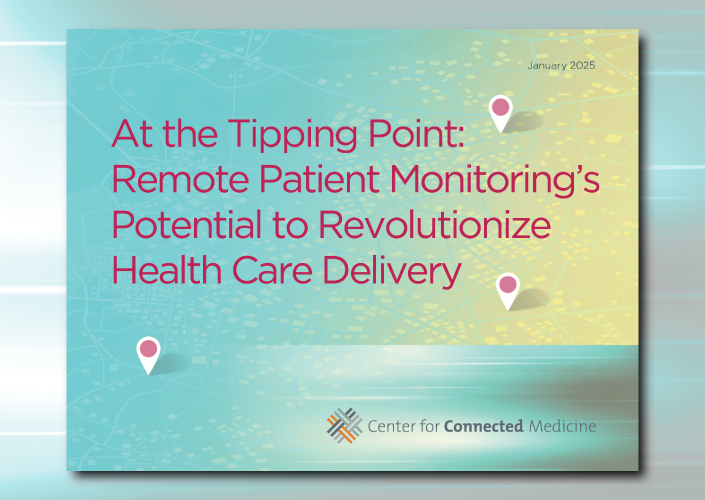Download report to read expert opinions about CCM research on telehealth adoption and use at health systems
Telehealth use at health systems is leveling off following a peak-pandemic high in 2020, according to a Center for Connected Medicine (CCM) research report published in September 2021.
But that finding shouldn’t be a cause of concern, according to three experts who reviewed the report, “The Intersection of Value and Telehealth.”
While many providers have returned to seeing their patients in-person, the pandemic has spurred many health systems to explore new ways to deploy the technology to expand access and drive value.
In its latest Executive Outlook, the CCM interviews three experts on telehealth to bring greater context to the research findings. “Executive Outlook: Telehealth Adoption and Use at Health Systems” is available to download at the top of this page.
Telehealth extends care beyond clinical facilities
Glenn Updike, MD, Medical Director of MyUPMC and Medical Director of Clinical Informatics for the Women’s Health Service Line at UPMC, explains that the rapid scale up of telehealth use in the pandemic’s early days didn’t necessarily allow for a deliberate implementation with clinical workflows.
With less of a crisis pushing telehealth utilization now, health system leaders across the country have an opportunity to step back and be more thoughtful about where to deploy telehealth solutions to best serve patient needs.
“I think we’ll find that our systems can be modified to direct patients to whatever the venue of care that’s most appropriate for them,” Dr. Updike said.
[Report download: ‘Top of Mind Exchange: Telehealth’ roundtable focuses on future of telemedicine]
Telehealth can alleviate doctor shortages
Implementing telehealth programs can drive value for health systems by delivering care efficiently and extending clinical resources.
This is especially true for infectious disease programs, where there is a shortage of infectious disease doctors, according to Dave Zynn, CEO and President of Infectious Disease Connect Inc.
“It is difficult for a hospital to recruit and retain an infectious disease specialist, and it’s getting increasingly difficult,” Mr. Zynn said. “Without a specialist, it’s a burden on the hospitalist and surgeons, and the result is increased transfers from rural settings into an urban academic setting.”
Telehealth facilitates human connection
From an outcomes perspective, telehealth enables a patient anywhere to receive access to expertise that might not be readily available in-person.
That is the value proposition driving UPMC’s tele-ICU program, according to Rachel Sackrowitz, MD, Chief Medical Officer of the UPMC ICU Service Center and Executive Vice Chair of the Department of Critical Care Medicine at University of Pittsburgh and UPMC.
“Regardless of where the patient is geographically, he or she can receive the expertise to meet their clinical need right where they are without delay or transfer to a hospital far from family and loved ones. And that kind of a responsive, real-time, patient-centered model leads to better health care outcomes,” Dr. Sackrowitz said.
Additional CCM resources on telehealth
Report download: ‘Top of Mind Exchange: Telehealth’ roundtable focuses on future of telemedicine
New Report: Telehealth utilization settles in at 20% or less of medical appointments
Telehealth panel at Top of Mind Online tackles empathy in virtual care and range of other topics
Report: What’s needed to sustain telehealth, and measure and identify its value
Telehealth industry is poised to be the major disruptor in health care



